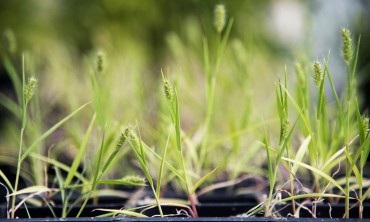Bond LSC Research

Aug. 19, 2015
The CRISPR Revolution at MU
By Caleb O’Brien | MU Bond Life Sciences Center James Amos-Landgraf, assistant professor of comparative medicine and genetics at the University of Missouri, is helping develop a pig model for colon cancer using CRISPR. //photo by CALEB O’BRIEN/Bond LSC James Amos-Landgraf needed a pig. The assistant professor of comparative medicine and genetics at the University of Missouri had joined forces with a startup company developing a tool to detect early colon cancer-causing lesions. They already tried out a rat-sized model, but still needed a full-sized prototype. Scientists in Europe had an ideal pig model for…

July 17, 2015
Bridging the gap between science and art
By Caleb O’Brien | MU Bond Life Sciences Center Tommy Langdon waits for a bee to land on a flower. // photo by CALEB O’BRIEN/BondLSC Emily Fulcher came face-to-face with science while dissecting a hackberry gall: “Ewww,” she exclaimed, “it’s peeking out a little bit!” Fulcher and 12 other high school students were observing plant galls as part of a Summers @ Mizzou camp exploring “The Arts as a Portal to Science Communication.” The camp, which ran Sunday through Thursday afternoon, was facilitated by three interdisciplinary scholars and artists adept at bringing together science and the arts:…

June 26, 2015
The view from the trenches: a conversation about Alzheimer’s disease
This immunofluorescence picture shows the brain of an Alzheimer’s disease mouse model, also known as the TgCRND8 mouse. In the picture, the amyloid beta plaques are stained green and the microglia, or immune cells of the brain, are stained red. Image courtesy of Luke Woods. By Caleb O’Brien | MU Bond Life Sciences Center Jean Camden and Luke Woods have an ant’s-eye view of Alzheimer’s disease. Both are bench scientists in the laboratory of Gary Weisman, a professor of biochemistry at the Bond Life Sciences Center. Jean has spent the past 12 of her 35…

June 22, 2015
Scientists uncover how caterpillars created condiments
Chris Pires and an international team gained insight into how Brassicales plants and butterflies genetically co-evolved over millions of years.

June 22, 2015
Scientists uncover how caterpillars created condiments
The next time you slather mustard on your hotdog or horseradish on your bun, thank caterpillars and brassica for that extra flavor. While these condiments might be tasty to you, the mustard oils that create their flavors are the result of millions of years of plants playing defense against pests. But at the same time, clever insects like cabbage butterflies worked to counter these defenses, which then started an arms race between the plants and insects. An international research team led by University of Missouri Bond Life Sciences Center researchers recently gained insight into a genetic basis for this co-evolution…

June 5, 2015
Filling in the gaps of HIV
Stefan Sarafianos' lab figured out how to get the full picture of a key HIV protein used to construct the capsid shell surrounding the virus' genes. The journal Science recently pulished this finding.

June 5, 2015
Filling in the gaps of HIV
By Caleb O’Brien | MU Bond Life Sciences Center The HIV capsid protein (shown above in an array of hexagons) plays a critical role in the virus life cycle. Bond LSC researchers recently developed the most complete model yet of this vital protein. Image by Karen Kirby and Anna Gres Seeing the whole picture can mean a lot when it comes to figuring out HIV. Researchers at the University of Missouri Bond Life Sciences Center are gaining a clearer idea of what a key protein in HIV looks like, which will help explain…

June 3, 2015
Poor parenting or BPA?
California mice exposed to bisphenol A (BPA) or ethinyl estradiol changed their parenting behavior, according to an MU Bond LSC study.

June 3, 2015
Poor parenting or BPA?
Endocrine disruptors alter parent behavior in California mice California mice exposed to bisphenol A (BPA) or ethinyl estradiol changed their parenting behavior, according to an MU Bond LSC study. | Photo by Roger Meissen, Bond LSC By Roger Meissen | MU Bond Life Sciences Center What if a chemical changes the way an animal parents? That could happen due to endocrine disruptors like bisphenol A (BPA). A recent study of California mice exposed to BPA showed parents spend less time feeding, grooming and interacting with their babies, according to University of Missouri research. Even mother mice not exposed to the…

May 28, 2015
Move over Arabidopsis, there’s a new model plant in town
Bond LSC researchers showed for the first time ever that a grass, Setaria viridis, can receive 100 percent of its nitrogen needs from bacteria when associated with plant root surfaces. This grass will now serve as model for research into biological nitrogen fixation that could benefit crop development.

May 28, 2015
Move over Arabidopsis, there’s a new model plant in town
Bond LSC researchers showed for the first time ever that a grass, Setaria viridis, can receive 100 percent of its nitrogen needs from bacteria when associated with plant root surfaces. This grass will now serve as model for research into biological nitrogen fixation that could benefit crop development. | Photo by Roger Meissen, Bond LSC By Roger Meissen | MU Bond Life Sciences Center As farmers spend billions of dollars spreading nitrogen on their fields this spring, researchers at the University of Missouri are working toward less reliance on the fertilizer. Less dependence on nitrogen could start with a…

May 21, 2015
Forest at your fingertips: smartphones enhance fieldwork
“Fieldwork” means many things to researchers, but in the past it often meant working without easy access to communication. Now cell phones allow my students visiting the La Selva Biological Station in the lowland rainforest of Costa Rica to remain connected.